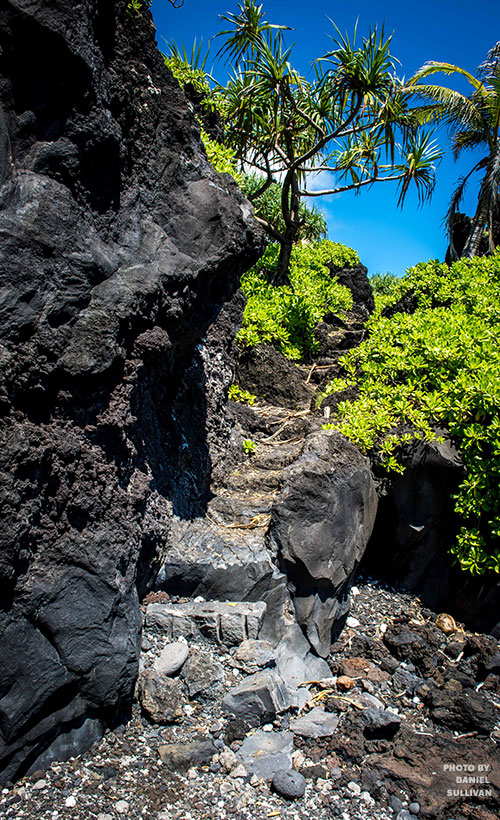Enjoy Kyle’s storytelling at the Wai‘ānapanapa section.
Seeing the village at all, in fact, requires creative vision, since grazing cattle, an overgrowth of kiawe trees, and a deadly tsunami in 1946 all greatly altered the landscape. Strolling the grounds of the Nu‘u property — which is open to the public — is like staring at one of those Magic Eye books where images are hidden in patterns; at first you don’t see the picture, but eventually it comes into focus. Walking the grounds with Fisher helps, since he’s able to pick up on details. He points out a sprig of nonnative basil growing right by a long, straight curb — indicative of someone planting here on the road built by Hoapili.
“If I was looking for a village, I’d look for basil,” he says as he picks off a leaf. The Hawaiians loved the aroma and flavor, and even though 150 years have passed since anyone lived here, the basil is still there, growing wild amidst the crumbling walls.
On a one-hour walk through the property, Fisher shows me the original Pi‘ilani Trail, embedded with ‘ili‘ili, as well as the wider Hoapili Trail with its impressively engineered walls. At some points the two join into one before going their separate ways, like a double helix that maps the D.N.A. of the area’s past.

Two days after the skin-scorching trek in Keone‘ō‘io, I drive to Hāna’s Wai‘ānapanapa State Park. Here in this lush, East Maui place known best for its black-sand beach, nearly four miles of the Pi‘ilani Trail run right along the coast. The ‘ili‘ili stones are more prominent here, and fallen hala leaves form a soft padding that’s easier on the knees.
It’s believed this section was completed during the reign of Kiha-a-Pi‘ilani, one of Pi‘ilani’s two sons who succeeded him after his death. When describing this section of trail in his book, Sullivan tells of ancient messengers, kūkini — specially trained runners who could cross the island in a single day by following the narrow path. There are many stories of ways kūkini would test their strength and speed, such as being handed a live fish, and needing to reach a certain village before the fish stopped wriggling.
Hiking the part of the trail that runs south from the park, I hug a coastline where palm trees hang over turbulent cobalt bays; sea spray propelled by the wind-driven waves blows vertically up the cliffs. Within fifteen minutes, the Ohala heiau suddenly comes into view. Standing in front of the ancient temple, I wish that more of this trail remained, and that more of its tales had been told; I wish the legend of the King’s Trail weren’t hidden beneath so much stone.





